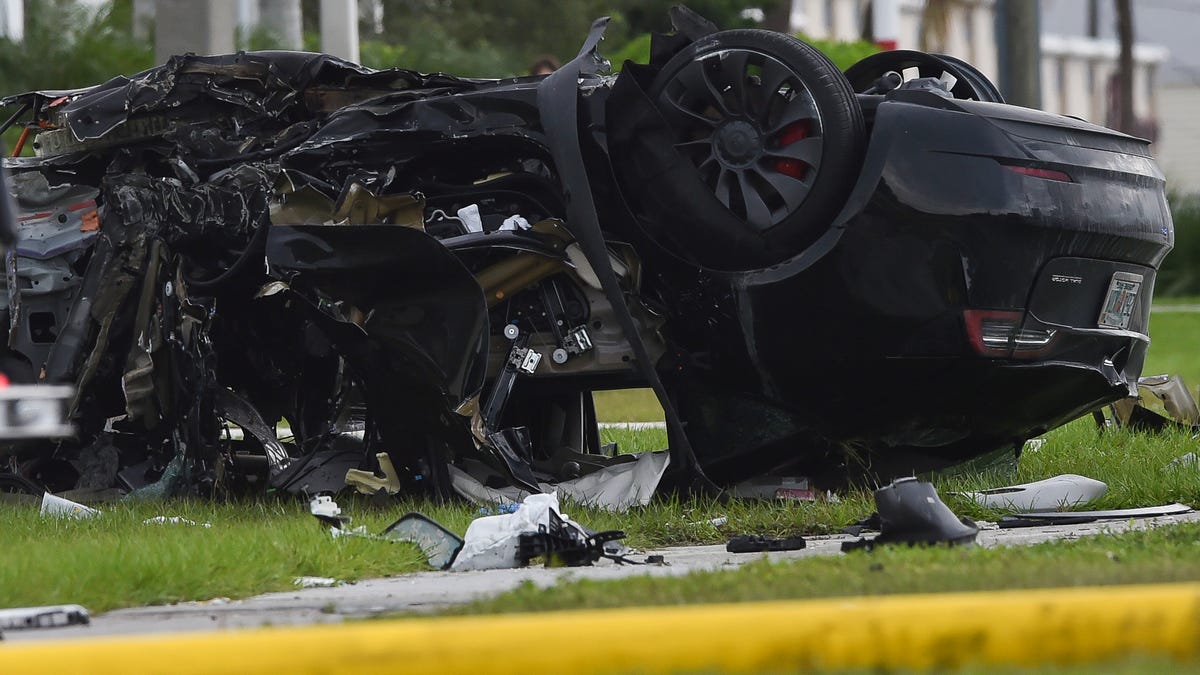Two people died on New Year’s Eve in West Palm Beach when their EV crashed and caught fire.
Electric vehicles, or EVs are the transportation mode of the future, but even they aren’t immune to potentially life-threatening fires that can be caused by a severe crash, just like their gas-powered counterparts.
A 47-year-old man and his passenger died after his 2022 Lucid EV crashed into a wall and the car caught fire minutes before midnight on New Year’s Eve in West Palm Beach. The flames rose as high as the hedges that line South Flagler Drive, according to footage from WPEC-Channel 12. City police said speeding and aggressive driving were factors in the incident.
In October, an 18-year-old man and 19-year-old woman in a Tesla died after colliding with a van, then overturning and catching fire in Martin County. According to officials, a preliminary investigation showed the Tesla was speeding.
A number of issues in gas-powered cars can lead to fires, such as engine failures, airbag explosions or electrical wiring damage, all of which can be compounded by the presence of flammable gasoline.
More stations:Florida gets big federal bucks to expand electric vehicle charging stations
Legislature:Bill could stop Palm Beach County’s plan to boost electric vehicle chargers
Palm Beach Gardens:FPL debuts first electric vehicle fast-charging station at Midtown
But for electric vehicles, the likely source of fire following a crash is their lithium-ion batteries.
Battery packs in EVs are made of hundreds or thousands of lithium-ion cells, said Patrick Currier, a mechanical engineering professor at Embry-Riddle Aeronautical University in Daytona Beach. Within the cells, lithium ions flow between the anode and cathode as the battery charges and discharges. The electrolyte, which shuttles the ions, contains flammable substances.
“If you get the exact wrong set of conditions, some of those materials can catch fire,” Currier said.
These battery packs are typically located under the floor of the car.
“What tends to happen is the individual battery cells can be punctured or dented or damaged in a way that causes them to internally short out,” said Raul Arbelaez, vice president of the Vehicle Research Center at the Insurance Institute for Highway Safety, a non – profit based in Virginia.
This short-circuiting causes the cell to heat up, and then leads to “thermal runaway” in which nearby cells heat up and eventually ignite.
“The challenge is, once it starts spreading, it gets harder and harder to stop it from spreading,” Currier said.
Electric vehicle fires are more difficult to put out
Putting out an electric vehicle fire is also more difficult than doing so on a gas-powered car. Firefighters in Southwest Florida experienced this after a handful of electric vehicles caught fire from being flooded by saltwater in Hurricane Ian’s storm surge.
It’s not just a matter of snuffing out the oxygen, as lithium ion cells contain oxygen. The battery needs to be cooled and that requires getting the water underneath the car. Arbelaez said it could take thousands of gallons of water to put out an EV on fire, and even then that might not be enough. Sometimes, when it appears the fire is out, the cells can reignite if the short continues to occur.
This happened when a 2014 Tesla Model S caught fire after a high-speed crash in Fort Lauderdale in the spring of 2018, killing the 18-year-old driver and one of his 18-year-old passengers. After firefighters extinguished the fire, and the car and debris were loaded onto a tow truck, pieces of the battery module caught fire, and reignited two more times during transport, according to a National Transportation Safety Board review of the crash.
Yet with a crash as intense as the one in West Palm Beach was, Arbelaez said he would expect a fire regardless of whether it was an electric vehicle or a gas-powered car.
“When you put that much power into a vehicle, acceleration rates tend to be higher, speeding tends to be higher, and the crash risk is higher,” he said, noting that some models of the Lucid EV have more than 1,000 horsepower. “If it were a lower-speed crash, I would be surprised (if there was a fire).”
Still, he would feel comfortable if his family members drove an EV.
More:US 1 north of Roosevelt Bridge shut down as quadruple fatal crash under investigation
“I think the biggest risk is when you take these vehicles to the limit and inevitably you lose control and are in a severe crash,” he said.
While electric vehicles on fire may catch more headlines than gas-powered cars because of their relative infancy, “EV fires are exceedingly rare,” said Liz Najman, content marketing manager for Recurrent, a firm that tracks used electric cars. Even so, “it of course can happen,” she said. EV manufacturers like Chevrolet and Hyundai have issued recalls about battery issues that lead to fires.
An analysis of government data by AutoInsuranceEZ found that there are fewer electric vehicle fires per 100,000 sales compared to gas-powered cars, at 25 fires versus 1,530.
Researchers are looking into ways to reduce fire risk in EVs, Currier said, such as the use of solid-state batteries. But there’s no telling when that would become a reality.
Hannah Morse covers consumer issues for The Palm Beach Post. Drop a line at hmorse@pbpost.com, call 561-820-4833 or follow her on Twitter @mannahhorse.

